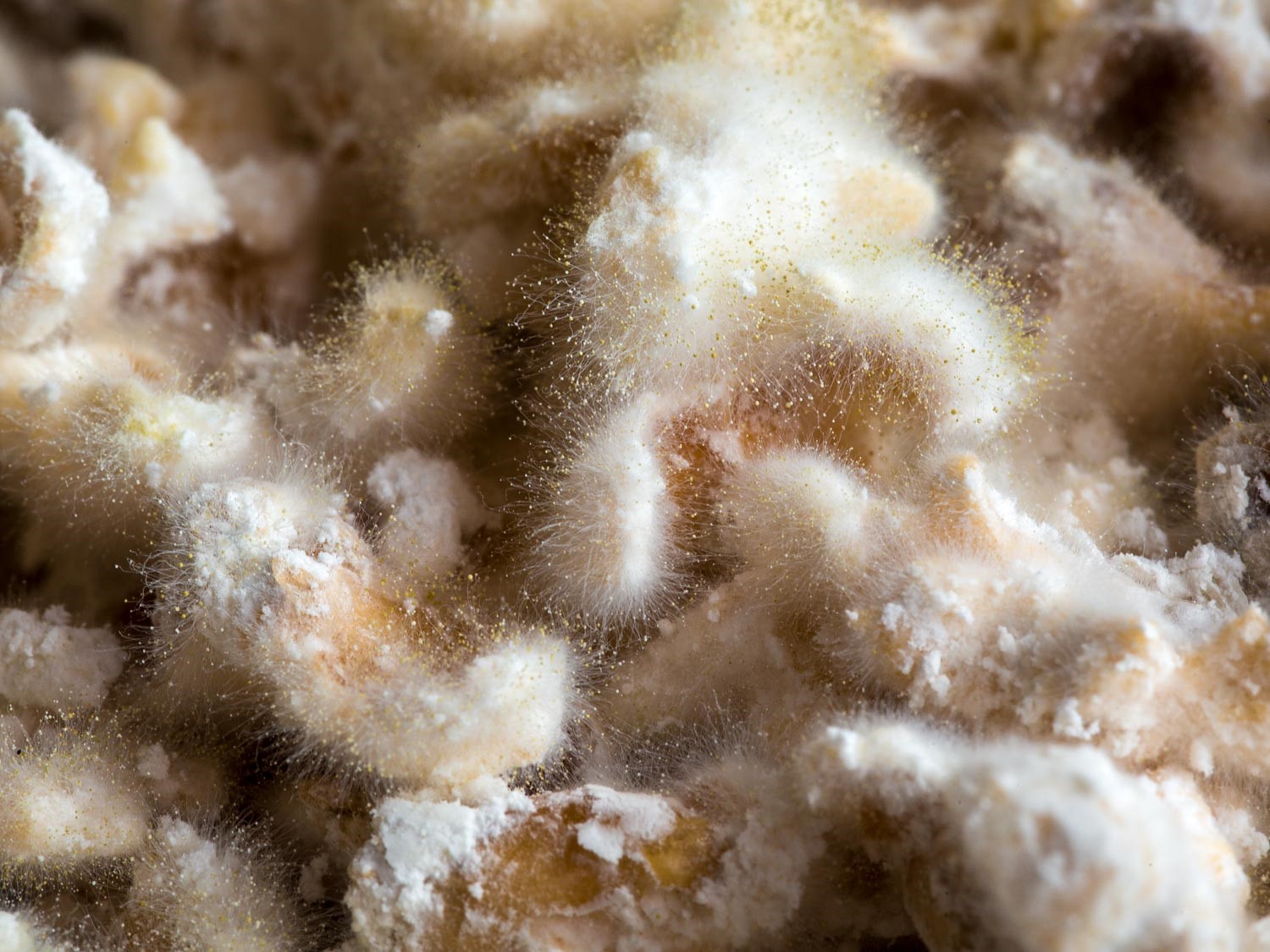By Bryan Quoc Le | 150 Food Science Questions Answered
Origins of Soy Sauce
The original predecessors of soy sauce began to appear in China more than 2,500 years ago. Salt was scarce and expensive at the time, and a method to extend salt was discovered by fermenting it with soy beans and fish [1]. During the Han dynasty around 220 BCE, Buddhism was beginning to expand into China from India. One of the precepts for Buddhists includes refraining from harming living beings [2], and so the original fermented sauce was split into two different fermentation products to prevent monastic and lay practitioners from eating foods produced from animals – fish sauce, and soy sauce as the vegetarian alternative [1].
Soy sauce became prominent in Chinese Buddhist cuisine, as it was one of the few strong flavoring agents available that could be used to enhance the flavors of an otherwise relatively bland vegetarian diet. Interestingly, highly pungent vegetables that are typically used to spice up cuisine, including onions, leeks, garlic, and shallots, were also abstained by monastics as they are said to overexcite the senses and increase sexual desire. Near the end of the 7th century, Japanese Buddhist priests studying in China returned home and brought with them methods of soy sauce production along with the Buddhist teachings [3]. While accepted by the Japanese ruling class, these first groups of Buddhists were not particularly popular with the common people at the time due to its complexity.

Enso, the symbol of emptiness in Zen Buddhism.
Source: http://www.jaredjuetten.com/2015/09/the-zen-life/
Even though soy sauce arrived around the 7th century it has been cited that the popularity of soy sauce only arose in Japan after 1254 AD [3]. That was when a Japanese Zen priest returned from China after learning to make a fermented miso-like soybean paste at a Chinese Zen temple and settled in the town of Yuasa, Japan. He discovered that the liquid dredges of the miso made excellent cooking and dipping sauce, which was unique from the previous versions of soy sauce brought over centuries before. The production method was shared and became the basis for modern Japanese soy sauces with their distinctive flavor. At the same time, Buddhism began to flourish after less complex forms of the tradition were propagated to the common people. Soy sauce development and production became an important activity conducted at these Buddhist temples.
Production Methods
Soy sauce is traditionally made using salt, water, soybeans, and wheat [4]. The soybeans are first steamed and the wheat toasted to provide the major foundations for soy sauce flavor. The treated ingredients are crushed, boiled, and mashed together in equal proportions with water, cooled down to about 80 degrees Fahrenheit, then inoculated with a special edible filamentous mold known as koji. Koji is composed primarily of Aspergillus oryzae, but most koji cultures contain some amount of other benign molds which add distinctive flavors to the soy sauce as well [4]. Different regions are known for their different koji strains, which impart flavors that reflect those areas of Japan. The koji releases a suite of protease and amylase enzymes into the raw material mixture. The proteases cause the soy and wheat proteins to hydrolyze into amino acids and small peptides. The amylases convert starches in the wheat into simple sugars, which provide energy for the koji to live and imparts sweetness to the soy sauce.

Rice grains inoculated with koji mold.
Source: https://www.seriouseats.com/2017/07/obsessed-koji-rich-shih.html
The mixture is fermented between 3 to 7 days in the dark inside large wooden vats. After the initial fermentation, the koji mixture is combined with water and salt, and further fermented with lactic acid bacteria and yeast to form a moromi, or solid-state mash, for several months [4]. The secondary fermentation process forms the hundreds of flavor molecules found in soy sauce; longer fermentation deepens the flavor profile in the same way as aging a wine does. The main driver for these transformations is the salt-tolerant yeast Zygosaccharomyces rouxxi, which contributes to the characteristic toasty, malty flavors of soy sauce [5]. Other major flavor products include ethanol and lactic acid. After completion, the raw soy sauce is filtered and pressed through cloth, and the liquid filtrate is pasteurized and bottled.
Soy sauce can also be made through a chemical method without koji or other cultures. It relies on a strong hydrochloric acid solution to hydrolyze the proteins in the soy by boiling them together over several hours, and is typically done to increase the speed of production from a few months to only a few days [6]. The acidic soy amino acid solution is neutralized with sodium carbonate and purified via filtration. Additives such as caramel, corn syrup, salt, and lactic acid, are combined with the liquid hydrolysate to mimic the appearance and flavor of a truly fermented soy sauce. Most inexpensive soy sauces at the grocery store are produced in this manner. A semi-fermented process is also occasionally used which involves adding wheat to the hydrolyzed soy and fermenting the mixture to produce a more authentic flavor profile. However, even though the chemical method has a significantly lower production time, it typically fails to generate the complex flavor profile associated with fully fermented soy sauce.
Chemical Composition
The primary flavor enhancer in soy sauce is monosodium glutamate (MSG), which imparts strong umami richness to foods dipped or cooked in soy sauce. Umami is the fifth category of taste that refers to the savory richness associated with beef, broths, and fermented foods. During the fermentation process, soy and wheat proteins are enzymatically hydrolyzed by the koji mold into simple amino acids. These proteins contain high levels of glutamic acid and glutamine residues, which are released and form MSG when mixed with salt. The secondary fermentation process with lactic acid bacteria and yeast is responsible for the diversity of soy sauce flavors. Soy sauce can differ in its sweetness, acidity, saltiness, aromaticity, texture, thickness, and the intensity of caramelization. Some of the most potent aromatic and flavor compounds that have been found in soy sauces include 3-methylbutanal (malty), sotolone (maple syrup-like), 2-methylbutanal (caramel), methional (cooked potato), ethanol (alcoholic), lactic acid (acidic) and ethyl 2-methylpropanoate (fruity) with hundreds of more giving variations in flavors between soy sauce types and brands [7].

Representative flavor molecules found in soy sauce.
Source: https://pubs.acs.org/doi/abs/10.1021/jf0709092
Soy Sauce Today
Five major traditional varieties of Japanese soy sauce are available today, with similar counterparts in other Asian culinary cultures [8]. Each have different uses in cuisine, from dipping sauce for sushi, to baking sweets, to cooking with stews, and each imparting distinct characteristics to the desired dish. Koikuchi is a dark soy sauce produced from equal portions of wheat and soybeans, and make up the bulk of all Japanese soy sauces. Usukuchi is a lighter, saltier soy sauce that uses a fermented rice ingredient called amazake to sweeten the sauce. Tamari is produced mostly or solely from soybeans as a gluten-free alternative; in contrast, shiro is made from mostly wheat. Saishikomi is a variation of koikuchi in which the soy sauce is twice brewed to form a much darker and more flavored soy sauce.

Kikkoman naturally brewed soy sauce. Source: http://www.rhamar.com/news/view/kikkoman-soy-sauce-appoints-rh-amar
The Japanese company Kikkoman is one of the major international producers of soy sauce and relies on traditional methods of fermentation combined with modernized steel and glass equipment to produce their products. However, some artisanal soy sauce producers still rely on older methods of production. The 250-year old Kamebishi brewery is the only Japanese company that relies on the mushiro method [9], a labor-intensive production technique in which koji mold spores are applied onto soybeans and placed on layers of bamboo mats with wheat that must be monitored for several days to maintain proper moisture and temperature conditions. The mash undergoes secondary fermentation over three years and uses aged soy sauce that has been fermented for two years instead of salt brine to add deeper, richer flavors. These soy sauces are nearly five times more expensive than their mass produced counterparts because of the time and expense put into these artisanal methods.

Zen Buddhist nun Jeong Kwan Source at work.
Source: http://minapark.com/journal/20/9/17/jeongkwannoodles
The Korean Zen Buddhist nun and famed chef Jeong Kwan was recently highlighted in the 2015 Netflix documentary series Chef’s Table [10]. She relies on soy sauces that have been fermented over years, decades, or even a century to cook Korean vegetarian dishes with flavors exhibiting subtlety and depth that rivals that of top chefs around the world. Kwan holds that soy sauce is an essential ingredient that represents the wisdom of her ancestors, imparting flavor to food that can uplift the inner self and connect one with the past, present, and future.
Since the discovery of soy sauce, the production methods have evolved with the times. With that, a whole new array of flavors, ingredients, and uses have been created to suit the palettes of consumers worldwide. Soy sauce is a commodity food, like wine or cheese, that can cost anywhere from a few dollars for cheaply produced hydrolyzed soy to premium aged brands that can be worth hundreds of dollars. However, the basic essence of soy sauce as a fermented seasoning that can add new depth to our food hasn’t changed much. Indeed, soy sauce remains a timeless seasoning in many cuisines around the world, that can transform dishes into sublime expressions of human creativity using an ancient Buddhist technology of fermentation transmitted through the ages and continues even today.
Want to keep up with the conversation? Follow us on Instagram and Facebook for quick updates on seminars, events, and food science!
References:
[1] Kurlansky, Mark. Salt: A World History. London: Bloomsbury Publishing, 2010. Print.
[2] Buddhaghosa, and Conze, Edward. “Five Precepts of Buddhism Explained.” Tricycle Magazine: The Buddhist Review, 2016, https://tricycle.org/magazine/the-five-precepts/. Accessed 9 May 2018.
[3] Shurtleff, William, and Aoyagi, Akiko. “History of Soy Sauce, Shoyu, and Tamari.” Soy Info Center, 2004, http://www.soyinfocenter.com/HSS/soy_sauce1.php. Accessed 8 May 2018.
[4] “Soy Sauce Brewing Process.” Shiso Soy Sauce. Shiso Soy LLC, 2018, https://shisosoy.com/soy-sauce-brewing-process/. Accessed 9 May 2018.
[5] Johnson, Arielle J. “Artisanal Food Microbiology.” Nature Microbiology, vol. 1, 2016, pp. 1-3.
[6] “Soy Sauce.” How Products Are Made. Advameg, Inc. 2018, http://www.madehow.com/Volume-3/Soy-Sauce.html. Accessed 9 May 2018.
[7] Steinhaus, Petra, and Schieberle, Peter. “Characterization of the Key Aroma Compounds in Soy Sauce Using Approaches of Molecular Sensory Science.” Journal of Agricultural and Food Chemistry, vol. 55, no. 15, 2007, pp. 6262-6269.
[8] Lee-Adrian, Jenny. “Do You Know Your Soy Sauces?” Serious Eats. Serious Eats Inc. 2011, https://www.seriouseats.com/2011/03/do-you-know-your-soy-sauces-japanese-chinese-indonesian-differences.html. Accessed 9 May 2018.
[9] Booth, Michael. “The Hunt for the Greatest Soy Sauce in the World.” SAVEUR. Bonnier Corporation. 2 Sept. 2016, https://www.saveur.com/best-soy-sauce-japan. Accessed 3 May 2018.
[10] “Jeong Kwan.” Chef’s Table. Netflix. 17 Feb. 2017. Television.

Bryan Quoc Le | 150 Food Science Questions Answered
IFTSA VP of Digital and Social Media (2019-2020)
Bryan is the author of 150 Food Science Questions Answered (Rockridge Press, 2020) and a Ph.D. candidate in Food Science at University of Wisconsin-Madison studying the health effects of garlic and onion flavors. He received his B.S. and M.S. in Chemistry at the University of California, Irvine. In another life, he walked 2,000 miles from California to Louisiana in six months, and learned that eating tuna and peanut butter every day was not meant for the average human body. After he met his wife, he learned that there was more to good food than canned goods and smoothies. While not juicing onions and pressing garlic, Bryan likes to run half-marathons, discover interesting cuisines with his wife, and help entrepreneurs develop great food products.






1 Comment